If you are reading these rules for the first time, ignore the text along the right hand side. These rules serve as a summary to help you quickly familiarize yourself with the game.
GAME SETUP
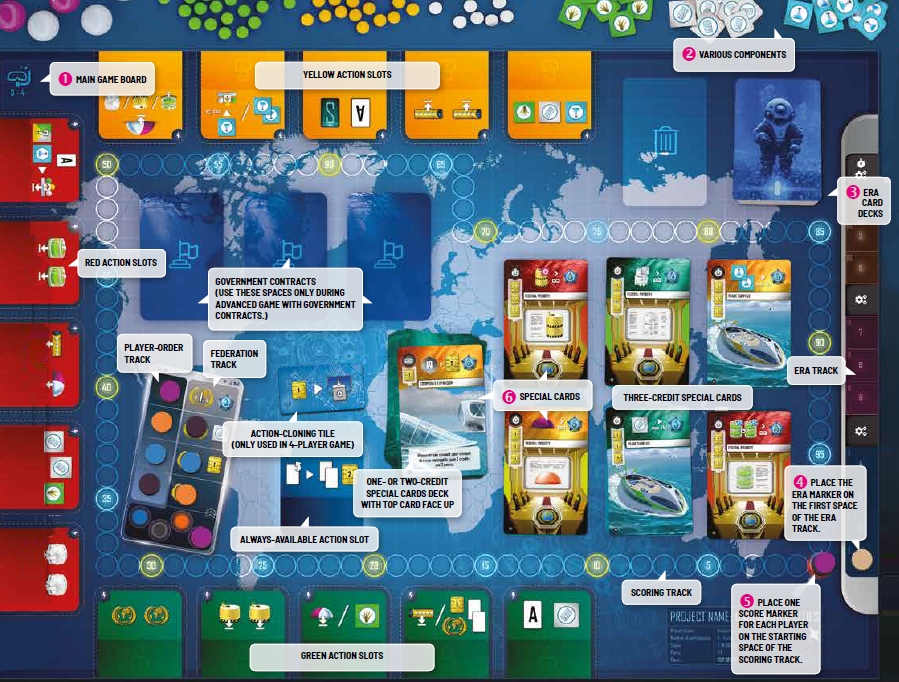
1
Place the main game board in the center
of the table. The board is two-sided. The side
shown here is used for a 3 or 4-player game.
Use the other side for a 2-player game.
2
The various components that represent
cities, tunnels, buildings, and resources
should be kept in a common supply.
If necessary, you can keep the supply
in two places so that everyone can reach the
components easily.
3
Cards with divers on the back are separated
into 3 decks, one for each era of the
game. The Era II and Era III decks can be set
aside right now. Shuffle the Era I cards face
down and place the deck on the main game
board, as shown.
Note: Thorough shuffling
is very important for this game. You don’t
want same-colored cards to be clumped
together.
4
Place the era marker on the starting
space of the era track.
5
Place one score marker for each player
on the zero space of the scoring track.
6 SPECIAL CARDS
Special cards represent specialists you can hire for
your underwater endeavors. Each has a cost near
the upper left corner.
Separate the Special cards into two groups:
-
A group that costs one or two credits.
-
A group that costs three credits.
Shuffle the deck of one-or-two-credit
Special cards and place it on the main
board. Turn the top card face up.
Shuffle the three-credit Special cards
and deal 6 face up to the corresponding
spaces in the center of the game board.
Return the rest of the three-credit deck
to the box. These 6 are the only
three-credit Special cards that will be
available during this game.
SETUP FOR 2 OR 3 PLAYERS
When setting up the game for fewer than four players, make two changes:
-
Leave the action-cloning tile in the box.
-
Use fewer symbiotic cities (purple domes):
-
With two players, use 7 symbiotic cities.
-
With three players, use 10.
A four-player game uses the action-cloning tile and all 13 symbiotic city domes.
>> PLAYER BOARD SETUP
Each player takes a different player board, chosen at random.
Your nation’s infrastructure begins with a city in the lower right corner
of your board. There are two types of cities – symbiotic and nonsymbiotic.
Your starting city is a nonsymbiotic city represented by a white dome,
as shown.
Separate the brown hexagonal metropolis tiles from the blue ones. Mix
up the brown ones and randomly give one to each player. Then mix up
the blue ones and randomly give two to each player.
Your brown metropolis goes on the hexagonal space in the upper left
corner. The other two should be randomly assigned to the remaining two
spaces.
The player boards are two sided. For your first game, use the side
depicted above (# 1-4, ☆). Later, for more variety, you can try the other
side, which has more asymmetry (# 5-8, ☆ ☆ ☆).
GAME PLAY
-
Players take turns by choosing one card to play and one
unused action slot (preferably the same color as the card,
otherwise the card is discarded). The chosen action slot
is marked with the player's action tile.
-
At the end of your turn, you always draw 1 card.
-
After 3 turns, the round is over and the era marker
advances one space. Possibly a production phase will follow.
Here is a quick summary of how the game is played:
>> PLAY ORDER
Players take turns choosing actions. They play in the order depicted on
the play-order track, and this order does not change during the round.
>> A TURN
You always start your turn with 3 cards. On your turn, you
play one card
and simultaneously choose one of the available action slots
. That is,
you choose a slot that no one else has chosen this round. (There is also a
special slot, explained later, that is always available.) You place one of your
action tiles on the slot to indicate that you have chosen it. This makes the
slot occupied and not available for the rest of the round.
If the color of the card you played matches the color of the slot you chose,
you also get to perform the card’s effect. If the color does not match, you
just take the action and discard the card with no effect – you assigned some
personnel to the job, but it was not their area of expertise, so they just did
the job without accomplishing any additional tasks.
At the end of your turn, you always draw 1 card. It’s also possible to draw
additional cards as part of an action or card effect. If you end up with more
than 3 cards, you will have to discard down to 3. You may discard any time
before you take your next turn.
Adaptation for the online game:
The cards which you draw during your turn will be shown to you after
you have finished your turn. You can discard down to 3 at the beginning
of your next turn.
>> A ROUND
Players continue until each has taken 3 turns. As cards are played, slots
will be occupied, making them unavailable for those who play later in the
round. The number of available slots will diminish. When everyone has taken
3 turns, it is the end of the round. The end of the round is described in detail
here.
>> THE ERA MARKER
At the end of each round, the era marker advances one space along the era
track. When it reaches a Production space, there is a Production phase.
>> PRODUCTION
During Production, your underwater network will produce various resources.
At the end of Production, each of your connected cities will consume
1 kelp. Details are here.
>> AN ERA
An era consists of 4 rounds in Era I and 3 in Era II and Era III. The end of
each Production phase marks the end of an era. New cards will come into
play, as explained here. The game has a different deck of cards for
each era. At the end of Era III, the game is done.
>> FINAL SCORING
At the end of the game, players score various aspects of their underwater
network, and the player with the most points wins.
ACTION SLOTS AND CARD EFFECTS
It is legal to use only part of an action or card effect.
However, you are not allowed to choose an action slot without using at least part of its effect.
On your turn, you choose an action by placing one of your action tiles on an
action slot. Slots that have already been chosen this round are occupied and
cannot be chosen again. Slots that have not yet been chosen are available.
The two sides of the main board have different action slots. One side is designed
for a two -player game. The other side is designed for three or four.
A key for action slots of each board can be found here.
When you place your tile on an action slot, you must also play a card from
your hand. The action slots and the cards come in three colors. If the color
of your card matches the color of the action slot, you may resolve the card’s
effect before or after you perform the slot’s action. If the colors do not
match, you ignore the card and only perform the slot’s action.
It is legal to use only part of an action or card effect. For example, if an
action slot allows you to build a city and a tunnel, you can choose to build
only the tunnel, if you wish.
However, you are not allowed to choose an action slot without using at
least part of its effect. For example, if you do not have enough resources to
build 1 tunnel, you cannot choose the action slot that allows you to build
2 tunnels.
Card effects are always optional, so it is legal to play a matching card and
not use its effect at all.
In this section we will illustrate core gameplay concepts with action slots,
but these rules also apply to many of the card effects as well.
>> RESOURCES
In general, credits, science, kelp, steelplast, and biomatter are used to pay
costs. Kelp is also used for feeding your people (there are other ways to feed
people, but kelp is the most efficient). Cards, of course, are useful because
they give you more choices on your turn. And points are how you win the
game. So anything you gain is sure to be useful to you sooner or later.
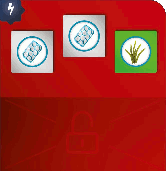
EXAMPLE:
The player who chooses this action slot will
take 2 steelplast tokens and 1 kelp token
from the supply and keep them near his or
her player board.
You can organize your claimed cards by type. The icons on top allow
you to lay them out compactly, as shown.
LIMITED AND UNLIMITED COMPONENTS
-
Credits, kelp, steelplast, science, and biomatter tokens are
not intended to be limited.
If the supply runs low, you can use higher
denominations and the multiplier tiles to represent the amount of
resources you have. You can make change freely at any time.
-
Building tokens are not intended to be limited.
If you run out of
a particular type, you can usually substitute a different colored token.
For example, if players have lots of upgraded farms, the supply might
run out of green tokens. You can get more in the supply by replacing
the bottom tokens of some upgraded farms with a color you have
lots of. The green token on top is sufficient to remind you that it is an
upgraded farm.
-
Tunnels and nonsymbiotic cities are limited.
The supply
starts with 46 tunnels. When they are gone, no one can build tunnels
anymore. Similarly the game has only 17 nonsymbiotic city domes, and
no more than this may be built.
-
Symbiotic cities are limited. The limit depends on the number
of players:
-
In a two-player game, use 7 symbiotic city domes.
-
In a three-player game, use 10.
-
In a four-player game, use all 13.
-
The era deck is not limited.
If it runs out of cards, shuffle
its discard pile to make a new deck.
-
You should not run out of one- or two-credit Special
cards.
Whenever these are “discarded” they return immediately
to the bottom of the deck.
-
Three-credit Special cards are limited.
Only six are
available in the game.
>> CITIES
-
Pay 2 steelplast, 1 kelp and 1 credit for a nonsymbiotic city (white dome);
-
Pay 1 steelpast, 1 kelp, 1 biomatter and 2 credits for a symbiotic city
(purple dome).
-
The site you choose for your new city must be adjacent to an existing city.
>> BUILDINGS
-
Build a farm.
This costs 1 kelp.
-
Build a desalination plant.
This costs 1 credit.
-
Build a laboratory.
This costs 1 steelplast.
-
The site you choose for
your new building must be adjacent to an existing city or adjacent to
a site on which you could build a new city.
-
You
can build on Expansion Sites (dashed circle and darker background) only if you play
a card with an effect that specifically
allows that.
EXPANSION SITES
Each city has an additonal building
site that is generally off limits. You
can build on this site only if you play
a card with an effect that specifically
allows you to build on an expansion
site (and only if it is adjacent to an
existing city or a site on which it is
legal to build a new city).
>> TUNNELS
-
Build a tunnel.
This
costs 1 steelplast and
1 credit.
-
The site you choose for your new tunnel must be connected to your starting city.
Tunnels connect your cities to your underwater network.
|
Tunnel
|
cost
|

|


|
|
Build a tunnel.
This
costs 1 steelplast and
1 credit.
|
When you build a tunnel, pay the cost and take a tunnel tile from the supply.
Place it on a tunnel site with the non-upgraded side up. The tunnel in
the illustration above is non-upgraded.
The site you choose for your new tunnel must be connected to your
starting city.
Tunnels are connected if you can trace a path along the
tunnels back to your starting city. The path can go through cities or through
empty city sites, but not through empty tunnel sites.
COSTS
The usual cost for building a city, building, or tunnel is depicted on your
player info card. This is the cost you pay when you build something by
choosing an action slot.
Certain card effects also allow you to build things. If the card does not
specify a cost, you pay the usual cost. However, if the card specifies
a cost, you pay that cost instead of the usual cost.
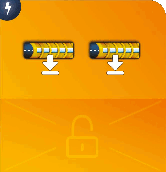
STEP-BY-STEP EXPANSION
You build your tunnels, buildings, and cities one-at-a-time. For example,
if you choose this action slot, you first build one tunnel on a legal
tunnel site and this could open up one or more new legal sites for the
second tunnel.
>> YOUR NETWORK
-
A city is connected to your network if there is a chain of tunnels from
it to your starting city.
-
A building adjacent to a connected city is connected to your network.
-
Buildings and cities that are not connected do not produce during
Production. They do not consume kelp at the end of Production. They do
not count during final scoring.
We have seen that tunnels must be connected to your starting city, but
buildings and cities do not have to be. This gives you freedom in how you
choose to expand. However, you eventually want everything on your board
to be connected to your network.
Your network is all the structures and cities and empty city sites that are
connected to your starting city:
-
By definition, your starting city is always connected to your network.
-
All your tunnels are automatically connected to your network because
building a tunnel that is disconnected is not legal.
-
A city is connected to your network if there is a chain of tunnels from
it to your starting city. Because all your tunnels are connected, any city
with a tunnel leading to it is connected and a city with no tunnels is not
connected.
-
A building adjacent to a connected city is connected to your network.
Buildings and cities that are not connected do not produce during
Production. They do not consume kelp at the end of Production. They do
not count during final scoring.
Biomatter is a remarkable substance, somewhat more rare than the other resources.
In addition to being essential for building symbiotic cities, biomatter can also be
a universal building material. Only when building a tunnel, building, or city, any part
of the cost that requires kelp or steelplast can be paid with biomatter instead.
EXAMPLE
A nonsymbiotic city normally costs 2 steelplast, 1 kelp, and 1 credit. But you could
build it with 1 steelplast, 2 biomatter, and 1 credit.
>> UPGRADING STRUCTURES
-
Whether upgrading a tunnel, a farm, a desalination plant, or a laboratory,
the usual cost is 1 science. However, the card effects offer you special cost
opportunities.
-
An upgraded tunnel still counts as a
tunnel, an upgraded farm still counts as a
farm, etc.
-
Upgraded structures produce more during Production, and certain cards
may provide benefits for having upgraded structures.
Buildings and tunnels are called structures in this game. Structures are
different from cities in that structures can be upgraded. There is a card
that will let you turn a nonsymbiotic city into a symbiotic city, but this is an
exception.
To upgrade, you need a card or action slot with a depiction like this:
|
Upgrade structure
|
cost
|

|

|
|
Upgrade 1 structure.
Pay 1 science.
|
Whether upgrading a tunnel, a farm, a desalination plant, or a laboratory,
the usual cost is 1 science. However, the card effects offer you special cost
opportunities.
When you upgrade a building, take the corresponding
token from the supply and stack it atop the structure you
are upgrading. To upgrade a tunnel, flip the tile over to the
upgraded side.
An upgraded tunnel still counts as a
tunnel, an upgraded farm still counts as a
farm, etc. It is not possible to upgrade any
structure that is already upgraded.
Upgraded structures produce more during Production, and certain cards
may provide benefits for having upgraded structures.
>> THE FEDERATION TRACK
-
When an action slot or card effect allows you to advance 1 space on this
track, move your marker 1 space ahead.
-
If there is a bonus depicted beside
that space, immediately gain the depicted resource.
-
If you move ahead
more than 1 space, gain the bonus of each of those spaces.
-
If you advance when you are already on space 1, put
your marker atop any others on space 1 and score 1 point for each space you
were supposed to advance.
We have explained how to build your underwater nation, but you also
need to build a good reputation with the world government! You do that
by choosing actions or playing cards with this symbol:

|
Advance 1 space on the Federation track.
|
Before the first round, players’ markers are placed on
separate spaces of the Federation track in reverse play
order, as explained here. At the beginning of subsequent
rounds, the markers begin below space 4, as
explained here.
When an action slot or card effect allows you to advance 1 space on this
track, move your marker 1 space ahead. If there is a bonus depicted beside
that space, immediately gain the depicted resource. If you move ahead
more than 1 space, gain the bonus of each of those spaces.
If your marker ends up on an occupied space, place it atop the other markers
which are already there (being atop other markers means you will play
ahead of them in the next round).
Even when you have advanced as far as possible, you can still gain benefits
from “advancing” more. If you advance when you are already on space 1, put
your marker atop any others on space 1 and score 1 point for each space you
were supposed to advance.
>> DRAWING SPECIAL CARDS
-
Take one of the three-credit Special cards.
-
Or take the top card from the deck (the one-or-two-credit deck) and
turn the next card face up.
-
Or turn the top card face down, move it to the bottom of the deck, and
draw the next 3 cards. Choose one of these 3 to keep and return the
other 2 to the bottom of the deck in either order. Then turn up the new
top card.

|
This symbol indicates that the action slot allows you to take a
Special card.
Many Special cards are available face up in the
center of the game board.
|
When you take a Special card, you either:
-
Take one of the three-credit Special cards (it is not replaced).
-
Or take the top card from the deck (the one-or-two-credit deck) and
turn the next card face up.
-
Or turn the top card face down, move it to the bottom of the deck, and
draw the next 3 cards. Choose one of these 3 to keep and return the
other 2 to the bottom of the deck in either order. Then turn up the new
top card.
-
Once a Special card is in your hand, it is mostly like any other card. The
differences are discussed here.
>> USING ACTION CARDS

|
You may use 1 of your action cards.
|
Action cards are a certain type of card you claim and keep near your player
board. They have actions which can be used during the game, but only when
you use an action slot or a card effect with this symbol:

|
You may use 1 of your action cards.
The rules for using action cards are
here.
|
>> THE ALWAYS-AVAILABLE SLOT
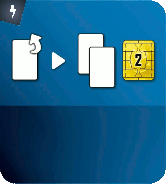
The always-available slot allows you to
gain 2 cards and 2 credits, and you discard
your hand card.

One action slot is always available, even if another player has already chosen
it this round. It has no color, so when you choose it you ignore the effect
of the card you play.
The always-available slot allows you to
gain 2 cards and 2 credits.
Note: Some Special card effects allow
you to use the action depicted at an action
slot. These effects apply only to the colored
slots, not to the always-available slot.
>> THE ACTION-CLONING TILE (4 PLAYERS)
-
Pay 1 credit to choose an action slot occupied by
another player.
-
Once the action-cloning tile is used, it cannot be used again for the rest
of the round.

In a four-player game, the
important action slots become
occupied quite quickly. The
action-cloning tile (which is
available only in a four-player
game) gives players a second
chance at one of these slots.
On your turn, instead of choosing an available action slot, you may do the
following:
-
Pay 1 credit.
-
Take the action-cloning tile.
-
Choose an action slot occupied by another player.
Your action tile goes on the slot you chose, on top of the other player’s tile.
You also play a card, as usual, and you gain the benefits of the card if its
color matches the chosen slot. Note that you cannot choose a slot that is
already occupied by your tile.
Note on card effects:
In a four-player game, “any slot occupied by another
player” actually means “any occupied slot not occupied by you”. The idea is
that if you have already placed a tile on that slot, a card that allows you to
use “any slot occupied by another player” will not allow you to use that slot
again. So a slot occupied by you and another player does not count as a “slot
occupied by another player”.
>> ONE-TIME USE
Once the action-cloning tile is used, it cannot be used again for the rest
of the round. The player who used the tile keeps it as a reminder that this
option is no longer available. The tile is returned to its place on the main
board at the end of the round.
>> SUMMARY OF CHOOSING AN ACTION SLOT
-
Choose an unoccupied action slot.
-
Play a card from your hand.
-
If the color of the card does not match, discard the card with no effect.
-
Otherwise resolve the card’s effect either before or after
performing the action.
-
Place one of your action tiles on an unoccupied action slot or on the
always-available slot.
-
Play a card from your hand.
-
If the color of the card does not match the color of the slot, perform
the action and discard the card with no effect. The always-available
slot has no color and cannot be matched.
-
If the color of the card matches, then you choose one of these:
-
Either perform the action, and then resolve the card’s effect.
-
Or resolve the card’s effect first, and then perform the action.
TIMING
Some effects have multiple parts. The parts of an effect can be resolved in
any order.
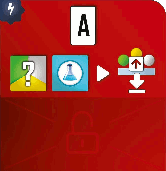
|
This action allows you:
-
Use one of your action cards
-
Build a structure for its usual price
-
Pay 1 science to upgrade just built
structure
|
We have already mentioned this action and it means, that you may build
any structure for its usual price and then to upgrade it immediately by
paying 1 science. In addition you can use one of your action cards. According
to the order of playing individual parts of this action, you can first use an
action card which gives you for example 1 credit and then you can pay this
credit and 1 science to build and immediately upgrade desalination plant.
Be careful!! You must resolve all card effects and then all actions from
an action slot or vice versa. Resolving these 2 sets of actions simultaneously
is not allowed.
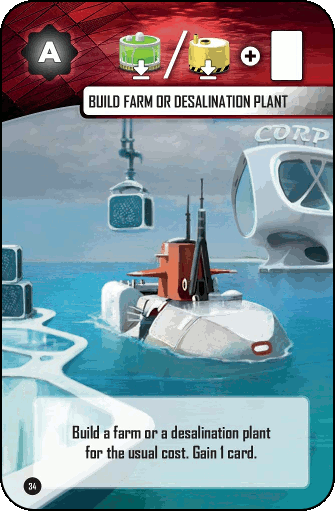
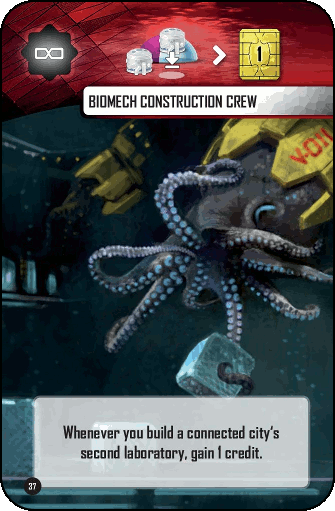
EXAMPLE
Suppose, that you have card with permanent effect no. 37 and action
card no. 34 and you decide to play a card to the red action slot described
above. In your supply you´ve got 1 steelplast and 1 science. You don´t have
any credits, but you would like to build a desalination plant. Here is the
description of how to do this with the resources and cards you have. First
of all, pay 1 steelplast and build a laboratory. You have built your laboratory
to a connected city and it is the second one, so because you claimed card
no. 37 before you gain 1 credit immediately. Then you have to pay 1 science
and upgrade the laboratory you´ve just built
(the whole action has to be
performed i.e. “build and upgrade” not just “build” or just “upgrade”)
. Now
you can resolve the other part of the action slot that allows you to use one
of your action cards . You will pay 1 credit, which you´ve gained to build a
desalination plant. And then you draw a card.
In this case there are two limitations with regard to resolving effects:
-
If a new effect triggers, resolve it immediately, even if you haven’t finished
the effect which triggered it (as with card no. 37 above).
-
You have to resolve a card effect and the action of the chosen action
slot separately and completely before resolving the other.
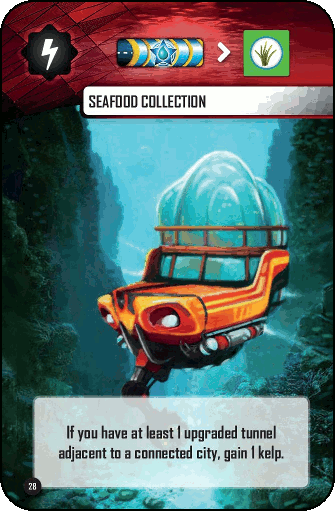
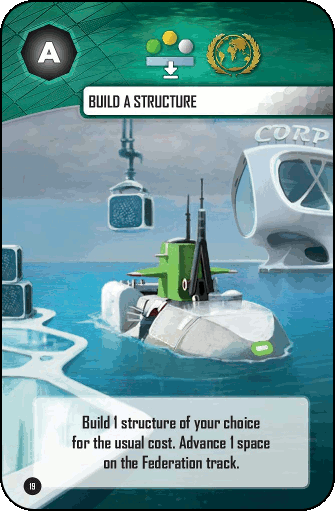
EXAMPLE
Kate chooses this red action and plays this red card no. 28. She also has this
action card no. 19, which she claimed on an earlier turn.
Suppose she has 1 steelplast, 1 credit, 1 science, no kelp, and no upgraded
tunnels. She is on space 4 of the Federation track.
The Seafood Collection effect is of no use to her until she has an upgraded
tunnel, so she decides to resolve the action slot first. The action slot allows
her to build and upgrade a tunnel. She pays 1 steelplast and 1 credit to build
it and 1 science to upgrade it. She can’t use Seafood Collection now because
she has not completely resolved the action slot’s effect.
The other part of the action slot’s effect allows her to use her Build A Structure
card. Kate has no resources for building, but she can use the second
part of the effect first. Kate advances 1 space on the Federation track. She
immediately gains 1 credit (effects on the Federation track are also triggered
effects which must be resolved immediately). Now she can spend that credit
to build a desalination plant, using the first part of the action card’s effect.
Both parts have been resolved, so the action card is resolved. And thus, the
entire action slot has now been resolved.
Now, and only now, can she use Seafood Collection. She has an upgraded
tunnel, so she gains 1 kelp.
There was no way for her to use this kelp to build a farm instead of a desalination
plant. The action slot and all its triggered effects had to be resolved
completely before she could use her card.
Of course it would have been legal to use the Seafood Collection card before
considering the action slot. In Kate’s situation, it would have been useless,
but if she had already built an upgraded tunnel on an earlier turn, she could
have gained the kelp before resolving the action slot.
Also it would have been legal to forgo using the action card Build A Structure,
and only use the "build and upgrade" a structure effect of the action slot.
PRODUCTION
>> TIMING OVERVIEW
-
After each era there will be a production phase.
-
The first era consists of 4 rounds, the second
and third era consist of 3 rounds each.
The era marker moves one space on the era track at the
end of each round. After 4 rounds, it will move onto a
Production space, reminding you that it is time for your
first Production phase. The second Production phase
happens 3 rounds later. The final Production phase
happens 3 rounds after that, just before final scoring. In all, you will play
10 rounds and have 3 Production phases. Each Production phase marks the
end of an era.
>> YOUR NETWORK’S PRODUCTION
-
Every tunnel adjacent to a city and every building in your network will produce something.
-
Symbiotic cities will produce 2 points!
-
Upgraded structures will produce more.
-
Production bonus for having 2 upgraded buildings of the same type at the same city.
-
For details see the production overview sheet.
All players can handle their Production simultaneously. Every tunnel
adjacent to a city and every building in your network will produce something.
Upgraded structures will produce more. Symbiotic cities will produce
2 points!
Nonsymbiotic cities have no production of their own, but they are still
useful because they connect buildings to your network.
You also gain a slight production bonus when you have 2 upgraded buildings
of the same type at the same city.
The production of your network is depicted on your player info card.
EXAMPLE
Each farm next to a connected city produces
1 kelp.
EXAMPLE
If this farm next to connected city is
upgraded, it also produces 1 point.
EXAMPLE
If you have at least 2 upgraded
farms at the same connected city,
they will also produce 1 additional
kelp and 1 additional point.
>> THINGS THAT DO NOT PRODUCE
A city will not produce if it is not connected to your network.
A building will not produce if it is not adjacent to a connected city.
A tunnel will not produce if it is not adjacent to a city (a tunnel
connecting a metropolis with a Production effect will allow the
metropolis to produce, but the metropolis does not help the tunnel
produce).
Think of it like this: The connected cities are the places where people can
live. It is the people who are doing the productive work. So a disconnected
city will not produce because no one lives there – they can’t move in until
you complete a tunnel to it. Similarly, a building next to an empty city site or
a building next to a disconnected city does not have anyone there to run the
operation. And tunnels that are not attached to any of your cities do not see
enough traffic to produce.
>> PRODUCTION FROM CARDS AND METROPOLISES
-
Apply the effects of your production cards and connected
metropolises.
-
Some production cards modify the production of your
structures or cities.
If you have claimed any production cards, or if
you have connected your network to any
metropolises with a production effect, you apply
their effects at this time. When evaluating a
production effect that depends on your cities
or buildings, you always ignore cities and
buildings that are not attached to your network.
Some production cards have no production of their own.
Instead, they can modify the production of your tunnels, buildings,
and cities. Such cards are evaluated when your network
produces, and they do not apply to tunnels, buildings, and
cities that do not produce.
>> END OF THE ERA
-
Rotate your used action cards to the usual orientation.
-
Feed your cities.
-
Replace the old era’s deck with the deck for the next era.
-
Each player draws 3 cards from the new era, adding them to any cards already in hand.
-
Discard hand cards until you have reached your hand limit.
After everyone has resolved all production from all sources, it is time to
resolve the end of the era with the following steps:
-
Rotate your action cards to the usual orientation to show they can be
used in the next era (this step is unnecessary at the end of the final
era).
-
Feed your cities (explained here).
-
Remove the old era’s deck and discard pile from the game. Players keep
any cards from that era that they currently have, but no more new
ones will be drawn.
-
Shuffle the next era’s deck and place it on the game board. This is the
new draw pile. Each player draws 3 cards from the new era, adding
them to any cards already in hand. From this hand of 6 or more cards,
choose 3 to keep and discard the rest.
(Discarded cards from the
new era go to the discard pile. Discarded cards from the previous era
should be returned to that era’s deck.)
Skip this step at the end of the
final era.
-
Advance the era marker.
Once everyone has discarded down to 3 cards, you are ready to play the
next era with the new deck; or if you have completed the third era, you are
ready for final scoring.
HAND LIMIT SUMMARY:
You must discard down to 3 cards at the beginning of your
turn and at the beginning of each era. At any other time, it
is okay to have more than 3.
If a card increases your hand limit by one, then you must
discard down to 4 cards at the beginning of your turn and
at the beginning of each era. It is still possible that you
will start one or more turns with only 3 cards, because
this effect only alters the way you discard, not the
way you draw.
>> FEEDING CITIES
-
For each city pay 1 kelp (as replacement 1 biomatter or 3 points, respectively).
-
Cities that are not connected do not count as cities to be fed.
At the end of Production, each city in your network must be fed 1 kelp (symbiotic
cities have the same requirements as nonsymbiotic cities). Return
this kelp to the general supply. If you have more cities than you have kelp,
you spend all your kelp to feed those you can and then feed the remaining
cities according to this chart:
For each unfed city, pay 1 biomatter. If any cities are still unfed, you feed
them by paying points – 3 points per city at the end of each Production. If
you lose all your points and still have unfed cities, just leave your scoring
marker at 0, but it would be extremely unlikely to lose this many points
unless you are deliberately trying to do so.
Only cities in your network require food. Cities that are not connected do
not count as cities to be fed because they do not have people in them yet.
VARIANTS
>> 1) GOVERNMENT CONTRACTS
Place 3 random government contracts
on the spaces of the main board at the beginning of
the game.
During play, any player may claim a government contract
as soon as he or she meets all its criteria.
Use these cards to give your game intermediate
goals that players can compete for. Shuffle the deck
of contract cards and draw 3 at random. Place them
on the spaces of the main board at the beginning of
the game. Return the remaining cards to the box.
During play, any player may claim a government contract
as soon as he or she meets all its criteria. The player keeps the card
and immediately gains its benefits. Claimed contracts are not replaced.
>> 2) THE OTHER SIDE OF THE PLAYER BOARDS
If you decide to try this
other side, everyone in the game should use it.
Some sites may have surcharges for building on them.
As additional kind of bonus there are now production multipliers;
a 2x multiplier indicates, that the usual amount is produced
one extra time.
The other side of the player boards is for experienced players. The cities
have variable numbers of building sites. The black-and-red sites are places
where you must pay surcharges - extra resources to build. They can give
you immediate bonuses or increased production. If you decide to try this
other side, everyone in the game should use it.
>> SURCHARGES
Some sites may have surcharges for building on them (these are not on
the side of the player board recommended for your first game). A surcharge
is applied after any discounts or cost reductions you may have.
For example, if an effect allows you to build on a site for free, you still must
pay the surcharge if you choose a site that has one.
The surcharge applies only to building on the site – it does not also apply to
upgrading.
>> PRODUCTION MULTIPLIERS
Production multipliers indicate that the usual level of
production is produced multiple times. More specifically,
the two-times multiplier shown on the side means that the
structure produces the usual amount one extra time. For
example, two upgraded desalination plants at a connected
city will normally produce 3 credits and 2 biomatter. If one of them has this
multiplier, it will produce an additional 1 credit and 1 biomatter, for a total of
4 credits and 3 biomatter.
As you can see from the example, the multiplier
applies to the usual production of an upgrade, but
not to any additional production associated with
the site.
Multipliers are not applicable outside the Production
phase. For example, if a Trial Run allows you to gain the production
from an upgraded desalination plant with this multiplier, you gain only
1 credit and 1 biomatter. But during Production, it will produce
2 credits and 2 biomatter.
When you build a city on this site, you must pay
a surcharge of 3 steelplast and 3 credits. A connected
symbiotic city on this site produces 6 points
during Production (instead of 2). A nonsymbiotic
city does not produce points by itself and yields no
bonus on this site. The production bonus does not
apply to any buildings or tunnels.
When you build a tunnel on this site, you must pay
a surcharge of 1 credit. A tunnel on this site produces
three times during Production if it is adjacent to
a connected city. This means that a non-upgraded tunnel
would produce 3 credits and an upgraded tunnel would
produce 3 credits and 3 points.
This production bonus applies only if you have built both
tunnels. And, as usual, it applies only if the tunnels are
adjacent to a connected city. In that case, you gain an extra
2 credits when the tunnels produce during Production. This
extra production does not depend on whether the tunnels
are upgraded.
When you build a tunnel on this site, you must pay
a surcharge of 1 credit and 1 steelplast. During
Production, the connected metropolis produces
an additional 2 points. This bonus does not depend
on the tunnel‘s production.
When you build a city on this site, you must pay a
surcharge of 2 science and 2 credits. You immediately
gain 6 points, whether the city is connected
or not.
>> 3) SOLO GAME
-
Use the
advanced side of a player board and the two-player
side of the main board.
-
Take three tiles in a non-player color and use them
to occupy the rightmost action slot of each color.
-
At the end of each round, you take back your
action tiles and move all non-player action tiles one space clockwise.
-
If you did not advance on the Federation track, play your next round with
a fourth randomly chosen occupied slot.
-
You win if you finish with at least 7 connected cities and at least
100 points.
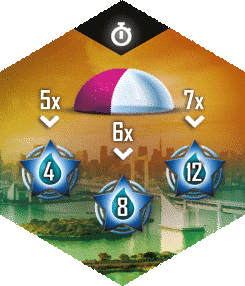
To play Underwater Cities by yourself, use the
advanced side of a player board and the two-player
side of the main board. The number of symbiotic
domes is not limited in this variant. Set up the game
as you would for two players, except do not use this
metropolis tile (shown here).
Take three tiles in a non-player color and use them
to occupy the rightmost action slot (first slot, if you
move around clockwise) of each color. Next time you
can occupy second, third etc. action slot of each color. You are going “first”,
so your marker should start below space 4 of the Federation track. You will
not need your player-order track marker.
>> GAMEPLAY
Play your round as usual. At the end of each round, you take back your
action tiles and move all non-player action tiles one space clockwise.
If you did not advance on the Federation track, play your next round with
a fourth occupied slot determined by this way:
-
Flip over the top card of the current era’s deck. Add its digits together
to get a number.
-
Starting with the first green action slot (as “1”) count around clockwise
until you get to that number. Place the new action tile on that slot,
if it is empty, otherwise, move the action tile clockwise to the first
empty slot.
The 3 non-player tiles of the same color always move one space clockwise.
The fourth tile is always placed randomly, and only if you did not advance on
the Federation track during the round.
>> GOAL
You win if you finish with at least 7 connected cities and at least
100 points. Track your score and try to beat your previous best.
Note: It is not possible to play the solo game with the government contracts.